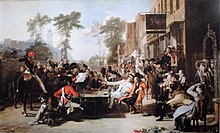David Wilkie (painter)
Sir David Wilkie RA (born November 18, 1785 in Cults in the Scottish county of Fife , † June 1, 1841 on board a ship near Malta ) was a Scottish painter.
Life
At the age of 14, Wilkie started studying at the Royal Scottish Academy in Edinburgh in 1799 . With the support of his teachers, he moved to the Royal Academy of Arts in London six years later . In the following year he was able to a. Participate successfully in the academy's large exhibition with his pictures “Die Dorfpolitiker” and “Der blinde Fiedler”; the latter was bought by the National Gallery .
In 1811 the Royal Academy of Arts made him a member and King George IV appointed Wilkie its court painter in 1823.
To restore his health, he lived in Italy and Spain from 1825 to 1828 , where he painted a series of scenes from the war on the Pyrenean Peninsula from 1808 to 1814. He followed Hogarth's style , with which he has in common the great variety, delicacy and sharpness of the observation of the characteristic in nature, in many of his pictures also the predominantly dramatic content, but was also essentially determined by the Dutch genre painters .
The paintings made after his return from Spain are more influenced by Titian and Velazquez . The images from this second period also include The Lord went out (1834) and Christopher Columbus (1835). In 1830 he was appointed the first court painter. In this capacity he painted many portraits, including those of the royal family. The historical paintings were also made: Pope Pius VII in Fontainebleau , refusing to sign the Concordat to Emperor Napoléon Bonaparte , Maria Stuart's escape from Lochleven Castle (1837), General David Baird , finding the body of the Tippoo Sahib (1839), Paul III. and Benvenuto Cellini .
Wilkie went to the Orient in 1840 and died on a ship near Malta on June 1, 1841 while returning. Most of his works are in royal private ownership.
Honors
A statue of Sir David Wilkie, created by Samuel Joseph (1791–1850), was placed in front of the National Gallery in London .
Works (selection)
- William Bethune with wife and daughter (1804)
- The village politicians ,
- The blind fiddler
- The Card Players (1808)
- The wounded finger ,
- The rent payment ,
- The children on the rat hunt ,
- The Gamekeeper ,
- The village fair (1812, in the National Gallery),
- The blind man's game , wood, 63 × 95 cm. London, Buckingham Palace.
- Duncan Gray (1812),
- The garnishment (1815),
- The rabbit on the wall (1816),
- The Breakfast (1817),
- The little messenger ,
- The Walter Scotts family (1818),
- The Penny Wedding (1819)
- The opening of the will (in the Pinakothek in Munich, 1820)
- Guess who? (1821),
- Chelsea veterans read an account of the Battle of Waterloo , 1822, wood, 94 × 154 cm. London, Apsley House.
- King George IV's arrival in Leith (1822),
- The sermon of John Knox in St. Andrews Cathedral
- The bailiff of the parish (1824) and
- The Mountain Family (1825).
- The only daughter (1839),
- Peep-o'day-boys-cabin ,
- The Saturday night of an hireling ,
- The first earring , 1835, wood, 74 × 60 cm. London, Tate Gallery.
- Empress Josephine and the fortune teller , 1837, canvas, 211 × 157 cm. Edinburgh, National Gallery of Scotland.
- Mohamed Ali , 1841, canvas, 61 × 51 cm. London, Tate Gallery.
- Pitlessie Fair , 1804, canvas, 58 × 107 cm. Edinburgh, National Gallery of Scotland.
- Wilhelm IV. , 1833, canvas, 264 × 173 cm. London, Apsley House.
- The grace ,
- The death of the red deer ,
- The Irish whiskey distillery (in the Hermitage in St. Petersburg)
- William Chalmers-Bethune, his wife Isabella Morison and daughter Isabella , National Gallery of Scotland, Edinburgh
- Garnishment , National Gallery of Scotland, Edinburgh
- The letter of recommendation , National Gallery of Scotland, Edinburgh
- Samuel in the Temple , National Gallery of Scotland, Edinburgh
- The Defense of Zaragoza , Royal Collection
- The Cotter's Saturday Nighter , Glasgow Art Gallery
- Queen Victoria's First Privy Council , Royal Collection
- The Seated Lady of Constantinople , British Museum, London
literature
- William J. Chiego: Sir David Wilkie of Scotland, 1785-1841. North Carolina Museum of Art, Raleigh 1987, ISBN 0-88259-953-4 .
- Allan Cunningham: The life of Sir David Wilkie. With his journals, tours and critical remarks on works of art. Murray, London 1843.
- Ronald S. Gower: Sir David Wilkie. Bell, London 1908.
- Thomas Nicholas (Ed.): David Wilkie. Painter of everyday life. Dulwich Picture Gallery, London 2002, ISBN 1-898519-20-X .
- Edward Pinnington: Sir David Wilkie and the Scots school of painters. Anderson & Ferrier, Edinburgh 1900.
- John Woodward (Ed.): Paintings and Drawings by Sir David Wilkie 1785-1841. Royal Academy of Arts, London 1958. (Exhibition catalog, 2 volumes)
Web links
| personal data | |
|---|---|
| SURNAME | Wilkie, David |
| BRIEF DESCRIPTION | British painter |
| DATE OF BIRTH | November 18, 1785 |
| PLACE OF BIRTH | Cults in County Fife, Scotland |
| DATE OF DEATH | June 1, 1841 |
| Place of death | at Malta |


